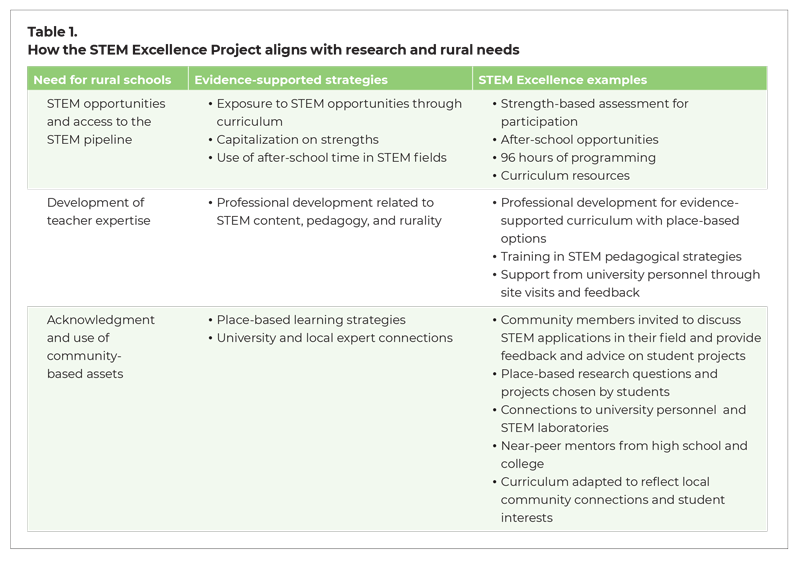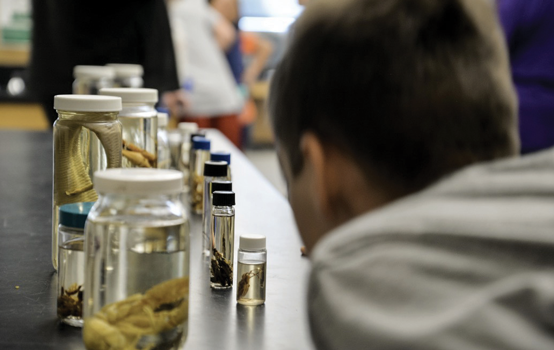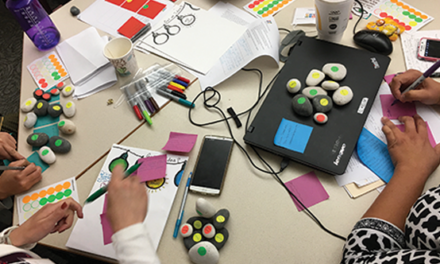A STEM Excellence student at a state hygienic lab examines preserved specimens while learning about environmental science. Photo by Melanie Meierotto.
The STEM Excellence and Leadership Program helps rural students envision how STEM learning might apply to their lives.
Rural students tend to face a number of challenges that can keep them from pursuing college degrees and careers in STEM fields. For example, they are less likely than their urban and suburban counterparts to have family members or neighbors who work in STEM fields and can serve as role models (Hachey, 2020). Their schools tend to receive less outreach from industry representatives who can provide students with early exposure to STEM careers (Harris & Hodges, 2018; Lavalley, 2018). The smaller the school — and many rural schools are quite small — the harder it may be for students with STEM-related interests to find like-minded peers (Lapan et al., 2003). Further, many under-resourced rural districts are unable to offer the advanced math and science courses that college STEM programs treat as prerequisites (Saw & Agger, 2021) — for instance, completing calculus in high school is virtually required for success in college engineering programs, as is prior exposure to physics (Trusty, 2002). And, even if their schools do provide those courses, rural students may worry that pursuing a STEM career will require them to leave their hometowns to obtain the necessary credential (e.g., bachelor’s degrees) and find meaningful work, since many STEM jobs are found closer to a city hub (Peterson et al., 2015). Finally, rural children are less likely to attend college, and those who do attend are 60% less likely to enroll in STEM majors and less likely to persist than their urban and suburban peers (ACT, 2017; Kittleson & Morgan, 2012; National Center for Education Statistics, 2017; National Rural Education Association, 2016; Versypt & Ford Versypt, 2013).
Yet there are also many advantages to living in a rural community, and rural schools can and often do find ways to support students’ interests in STEM subjects. For instance, teachers and administrators in rural schools often belong to the same community as their students, know them and their family members, are aware if they have a particular interest in STEM fields, and will recommend them for whatever STEM internships, mentorships, and out-of-school opportunities are available. Further, compared to large urban and suburban schools, rural schools are often less bureaucratic and more willing to create independent study projects to allow students to pursue their interests or to arrange for them to take an advanced science or math class online or at a nearby community college. And perhaps most important, students from rural areas often enjoy a deep sense of place and pride in their community (Stambaugh & Wood, 2015), which can serve as a powerful incentive to study STEM-related topics that are relevant to real-world challenges and opportunities in the local area (Bohanon, 2017).
So, how can rural educators build on these assets and provide more and better opportunities for their students to excel in the STEM subjects? Since 2015, the University of Iowa’s STEM Excellence and Leadership Project (STEM Excellence) has worked with science teachers in rural schools to nurture their students’ talents and interests in STEM subjects, mainly through after-school programming. And, through this work, we’ve identified some key principles and practices that can be helpful to rural educators across the country.
STEM talent development in the middle grades
STEM Excellence has focused on building a strong foundation for STEM teaching and learning in the middle grades, a period known to be vital to students’ long-term success in these subjects (Seward & Gaesser, 2018). Indeed, research into talent development has shown that early exposure and positive engagement — coupled with efforts to identify students with strong interest and ability — are important factors for developing expertise in any field (Subotnik, Olszewski-Kubilius, & Worrell, 2011). Further, students’ interest in science, technology, and mathematics tends to decline in the middle grades (Ardies, De Maeyer, & Gijbels, 2015; George, 2000; Osborne, Simon, & Collins, 2003), suggesting that interventions to maintain interest are vital in these grades. Because after-school programs allow teachers greater flexibility (Duschl, Schweingruber, & Shouse, 2007; National Research Council, 2015), the STEM Excellence leadership chose to focus on after-school programs for students in grades 5-8.
Researchers have found strong evidence to suggest that specific strategies — such as focusing on place-based instruction, honoring student strengths, and capitalizing on unique community-based assets — are essential to promoting career development and interest, especially in rural areas (Stambaugh & Wood, 2015). Too often, however, these strategies are implemented in isolation, diluting their impact. STEM Excellence has been careful to provide a comprehensive set of supports for teachers and students and conducted research to learn whether this combination of approaches results in greater student success over time.
The program originated in Iowa, where rural students make up 34.2% of the K-12 population (compared to 18.7% nationwide; National Center for Education Statistics, 2017). It seeks to (a) enhance teachers’ ability to identify rural students with high aptitude in STEM, (b) help rural schools expand their middle grades mathematics and science curricula, and (c) boost underserved middle grades students’ preparation for and eventual achievement in high-level mathematics and science classes in high school and beyond. Teachers from eight school districts in under-resourced communities currently participate in the program. Teachers identify students with high STEM aptitude and invite them to participate, and the program provides these students 96 hours of STEM after-school programming over 24 weeks, twice a week, for approximately two hours per session.
Participating schools looked for opportunities to use STEM principles to address problems within their communities.
Through initial funding from the Jack Kent Cooke Foundation for a pilot study, then a grant from the National Science Foundation’s Advancing Informal STEM Learning program, these eight districts entered a research-practice partnership with the University of Iowa leadership team at the start of the research study. The program implementation costs were fully supported, with teachers receiving stipends for their additional workload, and there were no participation fees. Selection for rural district participation was based on an application process to demonstrate commitment to implementation, to determine districts’ free- and reduced-price meal status, and to balance geographic representation across the state.
Program teachers and coordinators participate in two days (16 hours) of on-campus professional development (PD) during each summer of program implementation. PD includes modeling how to actively engage students in asking questions, investigating questions, and problem solving, as well as STEM talent identification and the social-emotional needs of gifted students. Over the years, the PD has responded to the needs of program teachers by, for example, developing sessions on twice-exceptionality (students with specific learning disabilities as well as strong academic ability), assessment data literacy, argumentation in STEM, attributes of effective out-of-school STEM programs, and positive youth development.
Teachers who facilitate the programs began their training by being introduced to two evidence-based curricula — the National Council of Teachers of Mathematics (NCTM) Navigation series (2001) and the Great Explorations in Math and Science (GEMS) curricula (Lawrence Hall of Science, 2009; see also Granger et al., 2009). Both curricula were selected for their ease of use, focus on core concepts, use of inquiry-based and student-centered instruction, and alignment to professional standards in science and mathematics education. These curricular resources were provided as a starting point, and many teachers chose to adopt or modify the resources for their own programs. For example, local programs developed curricular materials around community resources (a prairie restoration project); student and educator interest (building a butterfly garden); and STEM outreach (creating STEM festivals for elementary students). Technical assistance was provided to school districts as needed during the academic year.
Keys to successful STEM talent development in rural areas
Throughout this project, the STEM Excellence team conducted research to understand how the opportunities provided through the program shape the academic and psychosocial outcomes of rural, high-potential students, as well as to identify key characteristics of successful informal STEM learning environments for these students and their teachers. Joni Lakin and Tamra Stambaugh (the first two authors of this article) served as external evaluators and advisers. Our study, as well as previous research, provides insight into how to help rural teachers develop students’ STEM talents.

College students in a counseling program connect with STEM Excellence students to discuss career aspirations. Photo by Kristin Flanary.
Adapt programs to the locality and its students
In a major report on science learning in informal settings, the National Research Council (NRC, 2019) emphasized that educators in informal environments need to address students’ prior knowledge, experiences, and needs. Thus, a key feature of the STEM Excellence program was giving teachers agency to make their own decisions, particularly in choosing a curriculum or model that would be effective for students in that context. Teachers decided how best to adapt and implement the program to fit the needs of their students, while still meeting program goals of increasing STEM aspirations and achievement by engaging students in deep STEM learning through sustained curricular units, rather than superficial engagement in isolated activities. Local decisions were thus grounded in the practices modeled during the professional development, with attention given to students’ level of achievement, student interest, and community resources.
One way that teachers adapted their programming was to take a place-based approach. Place-based education — connecting the curriculum to project-based opportunities and connections within one’s locale — energizes teachers, promotes student achievement, and strengthens connections among schools, students, and the community (Place Based Education Collaborative, 2010). Participating schools looked for opportunities to use STEM principles to address problems within their communities. For example, students in one school created hydroponic gardens to address food insecurity within their school community. Students in another school used 3D drafting and design software to create solutions for buildings in the area affected by recent floods. Students in another school were given the opportunity to determine what to do with a parcel of land adjacent to the school, so they worked with community planners and local conservationists to oversee a prairie restoration project that included outdoor classroom spaces and walking paths. Some teachers modified existing invention programs so that students could use the tools within those programs to solve problems of local or personal relevance. Some schools held local invention competitions, and others participated in state and national invention conventions.
The most successful STEM Excellence programs evolved to allow students to choose the focus of their program and pursue projects that were meaningful to them, such as the hydroponic garden and prairie restoration project described above. When teachers give students the opportunity to exercise choice in this way, groups of students will tend to coalesce around areas of particular interest, which may shift over time with new cohorts, and the projects will tend to connect to their sense of place.
Encourage many students to participate
Students can opt into or out of after-school programs, but teachers have an important role in ensuring these programs are accessible and attractive to a wide variety of students. Teachers were trained to proactively look for potential STEM talent among students who come from groups that are underrepresented in STEM, including girls; Black, Latinx, and Indigenous students; students with disabilities; and students from low-income families. Teachers were charged with encouraging more students from those backgrounds to participate in available programs and to identify students from all backgrounds who would benefit from additional challenge in STEM areas.
To recognize talent from a wide range of backgrounds, teachers were encouraged to consider grade-level assessments, above-level assessment scores, and psychosocial measures to recognize talents and areas of need. These data were not used to exclude any student from participating, but instead to see if students had characteristics beyond academic aptitude that might make them more likely to benefit from the program. In fact, STEM Excellence teachers have observed students develop leadership skills as well as STEM skills through the program.
Rural teachers, in particular, have to be sensitive to how challenging it may be for students to participate in programs outside the school day, when transportation might not be available. Some districts are able to arrange transportation for students in after-school programs, while others incorporate extracurricular periods during the regular school day, such as during an extra period or during breakfast or morning drop-off.
Provide access to expertise within and outside the community
In its review of research on science-learning in informal settings, the NRC (2009) suggests that leaders of after-school programs make it a priority to create or leverage partnerships between science-rich institutions and local communities. Local experts can help teachers create curriculum and activities that are rooted in real, local concerns, which is important to many rural students (Stambaugh & Wood, 2015). Access to experts within the community promotes a strong sense of place and community pride and shows students how their interests and strengths can be applied within their local area. This may help curb the exodus many rural communities are facing.
Local experts can help teachers create curriculum and activities that are rooted in real, local concerns, which is important to many rural students.
Local mentors in professional or academic positions are often valuable to students, but locating potential mentors and connecting students to them can pose challenges in rural areas. STEM Excellence teachers sometimes had to be creative in how they matched student interests to local resources, industries, or governmental agencies — by, for example, contacting local hobby groups to find experts in local horticulture. Although they were not included in the STEM Excellence program, local cooperative extension offices, which are often staffed with higher-education faculty and experts in STEM topics, can be valuable resources.
However, because rural students with exceptional academic talent may develop interests and expertise that exceed the knowledge available within their communities, rural educators may need to reach farther to provide students with suitable mentors and models. Luckily, technology is making virtual visits and collaborations more feasible, and university partnerships and field trips also provide additional opportunities for students to see potential futures in STEM. In STEM Excellence, participants took field trips to a variety of areas, including the University of Iowa campus, and were able to visit labs and meet with experts. These outside experts may have less local knowledge, but exposure to knowledge from outside the local community is also an important aspect of access and raising students’ aspirations. The local connections students make are important “mirrors,” reflecting back to students how what they are learning applies in the world they know, but field trips and access to individuals outside the community are important ”windows” to a world beyond their own experiences. Both mirrors and windows, as well as the sliding glass doors in between (Bishop, 1990), are needed to help students envision what STEM can mean in their lives now and in the future.
Connect students with near-peer mentors and role models
When partnering with higher education, it may be most effective to seek out undergraduate or graduate students to mentor students. Near-peer mentors (mentors who are just a few years older and in the next phase of their career development) can be more accessible and have more relevant knowledge to share with students than faculty (Tenenbaum, Anderson, & Yourick, 2014). They may, in some cases, even be more reliable and communicative than faculty members. STEM Excellence students worked with counseling psychology graduate students who conducted a career counseling workshop with students to reflect on their career interests and strengths and consider potential pathways in STEM.
Because STEM Excellence is a middle school program, high school students can also serve as role models. For example, some participants saw how high school students used their STEM knowledge by watching them present projects at the Junior Humanities and Science Symposium, a regional research competition. One STEM Excellence program created a near-peer mentoring program by having recent graduates of the program (now in high school) serve as peer mentors to the middle school students, attending sessions focusing on computer programming and assisting with more complex projects. The middle school students found the program so rewarding that they decided to mentor elementary students in the same district as those younger students engaged in robotics projects.
As programs continue to grow, students who enter college can also serve as near-peer mentors, either in person or virtually. College students who value their community will enjoy the opportunity to stay connected to it while serving as a role model to others. Maintaining a network of graduates can grow a program’s capacity for near-peer mentors and access to local industry partners as those students graduate college and enter STEM careers.
Meeting student and community needs
Table 1 shows how the STEM Excellence project focused on the needs of rural schools and applied evidence-supported strategies to promote STEM access and the development of expertise. Project researchers have disseminated more detailed accounts of these results as related to opportunity gaps, economic disadvantage, and gender (Assouline et al., 2017, 2020; Ihrig et al., 2018).

Developing the talent of rural students brings more complexity than rural education or gifted education alone (Rasheed, 2020). Place-based, youth-driven STEM programs are one way to recognize and develop the STEM talents of rural youth. Connecting STEM learning in rural areas with place-based and choice-based after-school options, coupled with teacher professional development and university partnerships, can promote STEM interest and a love of one’s area without forcing students to choose between STEM learning or their community. Programs like STEM Excellence promote the best of both worlds, providing access to opportunity within one’s community and opening windows to STEM pathways that extend beyond it.
References
ACT (2017). STEM education in the U.S.: Where we are and what we can do. Author.
Ardies, J., De Maeyer, S., & Gijbels, D. (2015). A longitudinal study on boys’ and girls’ career aspirations and interest in technology. Research in Science & Technological Education, 33 (3), 366-386.
Assouline, S.G., Ihrig, L.M., & Mahatmya, D. (2017). Closing the excellence gap: Investigation of an expanded talent search model for student selection into an extracurricular STEM program in rural middle schools. Gifted Child Quarterly, 61 (3), 250-261.
Assouline, S.G., Mahatmya, D., Ihrig, L., & Lane, E. (2020, April). High-achieving rural middle-school students’ academic self-efficacy and attributions in relationship to gender. High Ability Studies, 1-27.
Bishop, R.S. (1990). Mirrors, windows, and sliding glass doors. Perspectives: Choosing and using books for the classroom, 6 (3).
Bohanon, M. (2018, August 16). Innovative programs expose rural students to opportunities in STEM. Insight Into Diversity.
Duschl, R.A., Schweingruber, H.A., & Shouse, A.W. (Eds.). (2007). Taking science to school: Learning and teaching science in grades K–8. National Academies Press.
George, R. (2000). Measuring change in students’ attitudes toward science over time: An application of latent variable growth modeling. Journal of Science Education and Technology, 9 (3), 213-225.
Granger, E.M., Bevis, T.H., Saka, Y., & Southerland, S.A. (2009, April) Learning about space science: Comparing the efficacy of reform-based teaching with a traditional/verifications approach. Paper presented to the 2009 American Educational Research Association conference, San Diego, CA.
Gross, B. & Opalka, A. (2020). Too many schools leave learning to chance during the pandemic. Center on Reinventing Public Education.
Hachey, A.C. (2020). Success for all: Fostering early childhood STEM identity. Journal of Research in Innovative Teaching & Learning, 13 (1).
Harris, R.S. & Hodges, C.B. (2018). STEM education in rural schools: Implications of untapped potential. National Youth-At-Risk Journal, 3 (1).
Ihrig, L.M., Lane, E., Mahatmya, D., & Assouline, S.G. (2018). STEM Excellence and Leadership program: Increasing the level of STEM challenge and engagement for high-achieving students in economically disadvantaged rural communities. Journal for the Education of the Gifted, 41 (1), 24-42.
Irvin, M.J., Hannum, W.H., Farmer, T.W., de la Varre, C., & Keane, J. (2009). Supporting online learning for advanced placement students in small rural schools: Conceptual foundations and intervention components of the facilitator preparation program. The Rural Educator, 31 (1), 29-37.
Kittleson, T. & Morgan, J.T. (2012). Schools in balance: Comparing Iowa physics teachers and teaching in large and small schools. Iowa Science Teachers Journal, 39 (1), 8-12.
Lapan, R.T., Tucker, B., Kim, S.K., & Kosciulek, J.F. (2003). Preparing rural adolescents for post‐high school transitions. Journal of Counseling & Development, 81 (3), 329-342.
Lavalley, M. (2018). Out of the loop: Rural schools are largely left out of research and policy discussions, exacerbating poverty, inequity, and isolation. Center for Public Education.
Lawrence, B.K. (2009). Rural gifted education: A comprehensive literature review. Journal for the Education of the Gifted, 32 (4), 461-494.
Lawrence Hall of Science. (2009). Great explorations in math and science (GEMS). Author.
Lynn, R. & Glynn, J. (2019). Small town, big talent: Identifying and supporting academically promising students in rural areas. Jack Kent Cooke Foundation.
National Center for Education Statistics. (2017, December). Table 4. Selected statistics from the public elementary/secondary school universe; School year 2015-16. U.S. Department of Education.
National Council of Teachers of Mathematics. (2001). Navigation series middle school bundle 6-8. Author.
National Research Council. (2009). Learning science in informal environments: People, places, and pursuits. National Academies Press.
National Research Council. (2015). Identifying and supporting productive STEM programs in out-of-school settings. National Academies Press.
National Rural Education Association (2016). The voice of rural schools and communities. Author.
Osborne, J., Simon, S., & Collins, S. (2003). Attitudes towards science: A review of the literature and its implications. International Journal of Science Education, 25 (9), 1049-1079.
Peterson, B., Bornemann, G., Lydon, C., & West, K. (2015). Rural students in Washington State: STEM as a strategy for building rigor, postsecondary aspirations, and relevant career opportunities. Peabody Journal of Education, 90 (2), 280-293.
Place-based Education Evaluation Collaborative. (2010). The benefits of place-based education: A report from the Place-based Education Evaluation Collaborative (2nd ed.). Author.
Rasheed, M. (2020). Context and content in rural gifted education: A literature review. Journal of Advanced Academics, 31 (1), 61-84.
Saw, G.K. & Agger, C.A. (2021, June). STEM pathways of rural and small-town students: Opportunities to learn, aspirations, preparation, and college enrollment. Educational Researcher.
Seward, K. & Gaesser, A.H. (2018). Career decision-making with gifted rural students: Considerations for school counselors and teachers. Gifted Child Today, 41 (4), 217-225.
Stambaugh, T. & Wood, S.M. (2015). Serving gifted students in rural settings. Routledge.
Subotnik, R.F., Olszewski-Kubilius, P., & Worrell, F.C. (2011). Rethinking giftedness and gifted education: A proposed direction forward based on psychological science. Psychological Science in the Public Interest, 12 (1), 3-54.
Trusty, J. (2002). Effects of high school course‐taking and other variables on choice of science and mathematics college majors. Journal of Counseling & Development, 80 (4), 464-474.
Tenenbaum, L.S., Anderson, M.K., & Yourick, D.L. (2014). An innovative near-peer mentoring model for undergraduate and secondary students: STEM focus. Innovative Higher Education, 39 (5), 375-385.
Versypt, J.J. & Ford Versypt, A.N. (2013, June). Mapping rural students’ STEM involvement: Case studies of chemical engineering undergraduate enrollment in the states of Illinois and Kansas. Paper presented at the 2013 ASEE Annual Conference & Exposition, Atlanta, GA.
This article appears in the December 2021/January 2022 issue of Kappan, Vol. 103, No. 4, pp. 24-30.
ABOUT THE AUTHORS

Duhita Mahatmya
DUHITA MAHATMYA is an associate research scientist at the Belin-Blank Center for Gifted Education and Talent Development at the University of Iowa, Iowa City.

Joni M. Lakin
JONI M. LAKIN is an associate professor of educational research at the University of Alabama, Tuscaloosa.

Susan G. Assouline
SUSAN G. ASSOULINE is the Myron and Jacqueline N. Blank Endowed Chair in Gifted Education and director of the Belin-Blank Center for Gifted Education and Talent Development at the University of Iowa, Iowa City.

Tamra Stambaugh
TAMRA STAMBAUGH is an associate professor and the Margo Long Endowed Chair in Gifted Education at Whitworth University, Spokane, WA. She is the co-author of Unlocking Potential: Identifying and Serving Gifted Students from Low-Income Households .

Lori M. Ihrig
LORI M. IHRIG is an administrator at the Belin-Blank Center for Gifted Education and Talent Development at the University of Iowa, Iowa City.











